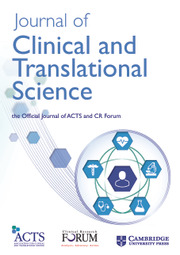In their recent article, Mendell and colleagues deepen our understanding team science (TS) competencies for team participants: (1) trainees/faculty, (2) clinical research professionals, and (3) community partners [Reference Mendell, Knerich and Ranwala1]. The authors’ insights conclude that competency development for community partners is more nonlinear than for the other two groups. We argue for many team roles, beyond community partners (e.g. experts by experience), TS competencies develop nonlinearly, fluctuating greatly by career stage, professional goals, and life experiences. Further, not every team effort requires mastery of every TS competency. We suggest expanding the nuanced approach that Mendell and colleagues recommend taking with community partners to all members of the team and the team overall [Reference Mendell, Knerich and Ranwala1]. Assessing current and desired skills for each team will both support the professional growth of individual members and ensure the team meets its specific goals.
In TS, each team member contributes their unique skills and background to their research teams, enhancing the team’s capacity to tackle scientific challenges [2]. These skills and backgrounds develop through diverse career and life trajectories for team members, not just community partners. This will be increasingly true as the academy diversifies, and new team structures emerge. For example, hybrid team roles like that of Community Health Workers (who are both community partners and clinical research professionals) demand specialized competencies that can differ significantly from the traditional academic research team roles as divided by Mendell and colleagues [Reference Mendell, Knerich and Ranwala1].
Synergy of team member competencies can advance the team’s scientific ambitions if matched to the needed tasks. For instance, in a large interdisciplinary research center, exemplary competency in managing interdisciplinary teams is crucial. This competency could be centralized in an individual or a group of directors (consisting of faculty and clinical research professionals, or community partners) with hybrid roles, each contributing different managerial expertise. In contrast, a small interdisciplinary project may not need this expertise to the same degree.
Team members learn via interaction [Reference Merriam, Baumgartner and Caffarella3], developing team-level competencies including communication and collaborative problem-solving skills. Balancing individual learning with the team’s progress requires a culture of open communication, shared goals, and reflection, enabling both individual and team competencies’ growth.
Considering how competencies develop through social learning, how project goals can vary, and how individual roles, skills, and aspirations are complex and dynamic, we suggest assessing both individual- and group-level competencies against the needs of a particular project. This could be done by creating a team development plan as the team starts and revisiting as the team evolves. This plan, informed by Lotrecchiano et al. [Reference Lotrecchiano, DiazGranados and Sprecher4]. and Mendell et al. [Reference Mendell, Knerich and Ranwala1], should align with individual development plans and highlight competency growth at the team level, tailored to the needs of that project.
By focusing on competency assessment, development, and maintenance across the team for a particular project, TS will be reinforced through a collective effort that acknowledges and supports all members, including those in complex, hybrid roles. An integrated tool, like a team development plan, could facilitate a more equitable and dynamic research environment that emphasizes collective progress and achievement.
Acknowledgments
Authors acknowledge the environment provided within the Michigan Institute for Clinical & Health Research where staff can be innovators. We would also like to thank the ongoing Learning Community, started by fellow author Dr Bethany Laursen who has created a community to discuss ongoing topics within team science.
Author contributions
Tara Truax and Patricia Piechowski conceived of the commentary and coordinated the writing, editing, and submission. All other authors contributed equally to the writing, editing, and approval of the final manuscript.
Funding statement
This work was supported by federal funds from the National Center for Advancing Translational Sciences through the CTSA Program grant UM1TR004404.
Competing interests
None.


